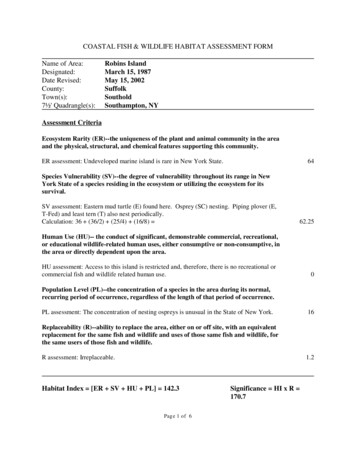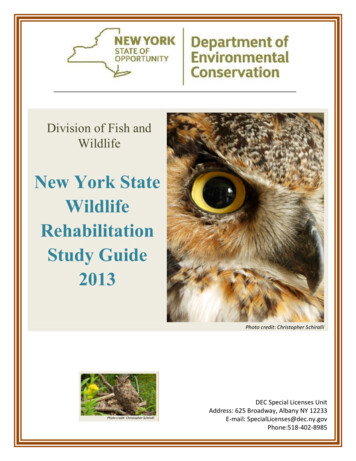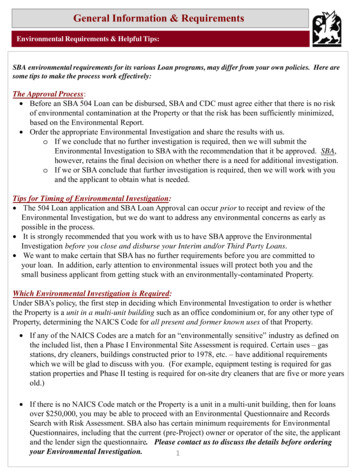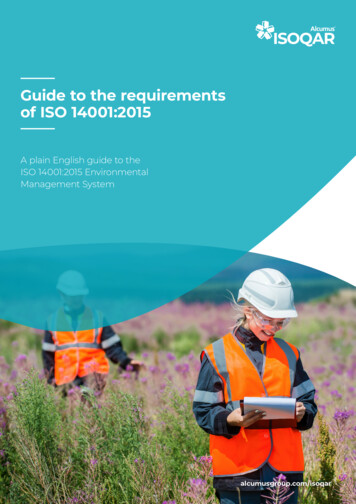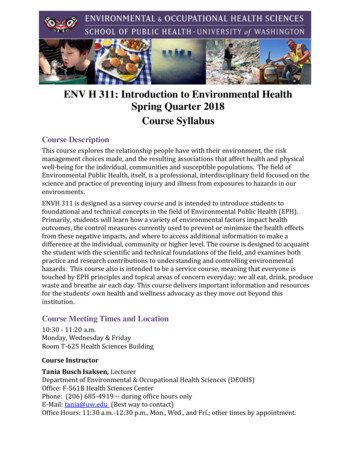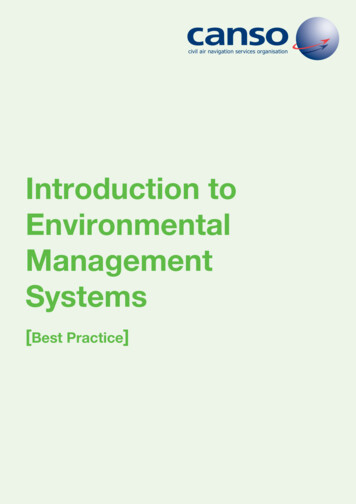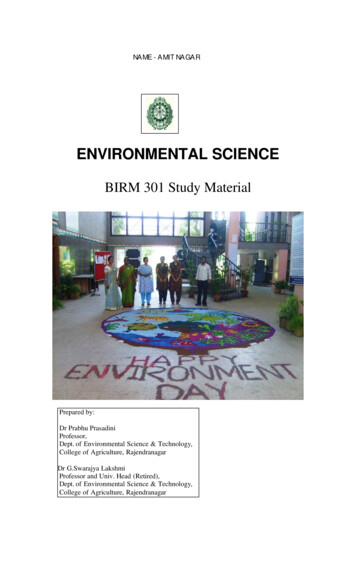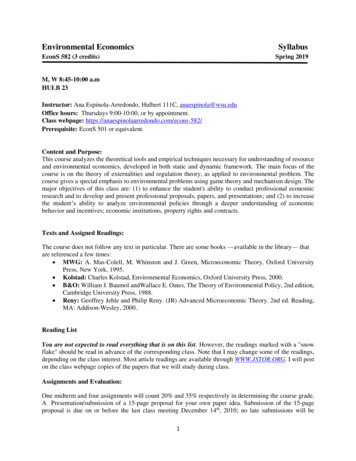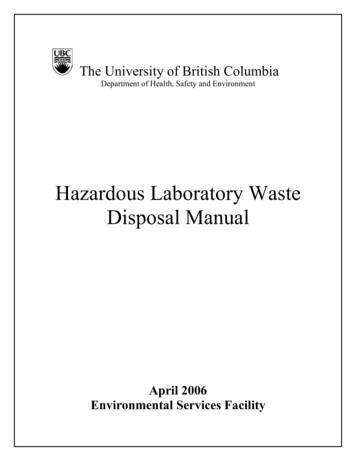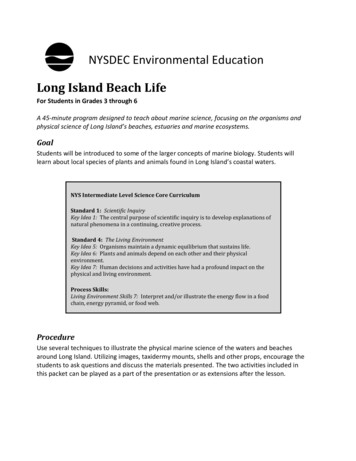
Transcription
NYSDEC Environmental EducationLong Island Beach LifeFor Students in Grades 3 through 6A 45-minute program designed to teach about marine science, focusing on the organisms andphysical science of Long Island’s beaches, estuaries and marine ecosystems.GoalStudents will be introduced to some of the larger concepts of marine biology. Students willlearn about local species of plants and animals found in Long Island’s coastal waters.NYS Intermediate Level Science Core CurriculumStandard 1: Scientific InquiryKey Idea 1: The central purpose of scientific inquiry is to develop explanations ofnatural phenomena in a continuing, creative process.Standard 4: The Living EnvironmentKey Idea 5: Organisms maintain a dynamic equilibrium that sustains life.Key Idea 6: Plants and animals depend on each other and their physicalenvironment.Key Idea 7: Human decisions and activities have had a profound impact on thephysical and living environment.Process Skills:Living Environment Skills 7: Interpret and/or illustrate the energy flow in a foodchain, energy pyramid, or food web.ProcedureUse several techniques to illustrate the physical marine science of the waters and beachesaround Long Island. Utilizing images, taxidermy mounts, shells and other props, encourage thestudents to ask questions and discuss the materials presented. The two activities included inthis packet can be played as a part of the presentation or as extensions after the lesson.
MaterialsBring a collection of assorted artifacts that may include: baleen, shells, taxidermy fish, sea turtleshell, horseshoe crab shell, taxidermy birds, shark teeth, and/or other appropriate materials.For activities, a playing area is needed. A large area such as a playground or auditorium is best,although demonstrations can be adapted to the classroom.Vocabulary ListBaleenBarrier BeachBayBeach ZoneBivalveCamouflageCoral Filter feedingFood chainFood webIntertidal zoneLittoral zoneMarine torPreySalineTideUnivalveConclusionsEncourage the students to ask questions or to share ocean experiences with the class (timepermitting). Do a short review of some of the discoveries made and answer questions studentshave about the marine environment.
Topics of DiscussionWhat is Salt Water?The water in the ocean is different from the water we drink. Salt is present in the ocean. Salt ispoisonous to many kinds of organisms. Most land plants die when exposed to salt water, and mostanimals cannot drink salt water.There are some animals that can tolerate salt water AND fresh water. Some kinds of fish can movein and out of fresh and salt water, and many species spend part of their life in fresh water, and partof their life in salt water.What Lives in the Ocean?Some of the largest and smallest animals on Earth live in the ocean. Plankton is what we call themicroscopic floating plants and animals in the ocean. Almost all marine food chains start withplankton. Illustrate food chains.Below is an example of a marine food chain.plankton amphipods small fish large fish sealsOne of the things to consider in marine habitats is that many animals interact in the ocean. Animportant part of the marine ecosystem is the dead material that falls to the bottom. This deadmaterial is called detritus and is fed on by many creatures.Below is an example of a detritus based food chain.detritus snails crabs large fish ospreyRather than view thefood system as achain, it may be morehelpful to view it as aweb.Where would humansfit into this food web?
Tide and TimeIf you are a snail or a crab living near a beach, life can be very different from hour to hour. Asthe moon orbits the Earth, it makes the water of the oceans move. This creates the tides. Thewater at low tide is further down the beach than it is at high tide. If an animal lives between thetides, in the intertidal zone, it will be exposed to the air at low tide, and under water duringhigh tide. There are many animals and plants that have adapted to living between the tides inthe intertidal zone. Remember that the animals have adapted to live there year-round, fromthe hot sun of the summer to the frozen icy spray of the winter.How Do Clams Eat?There are many animals in the ocean that do not move. Shell animals like oysters, mussels, andclams stay in one spot. They feed on tiny plankton drifting along by drawing salt water into theirbodies, removing the plankton with a filter, and expelling the water. It works like a filter in apool or a vacuum cleaner, and this feeding strategy is called filter feeding.The ocean’s largest animals are also filter feeders. Baleen whales draw in large amounts of seawater, filter out krill, squid and small fish, and expel the water. The special teeth they use forthis is called baleen. Other whales have teeth and eat larger animals- like fish, penguins, sealsand squid.Dangers of the SeaWhat eats little fish? There are many animals that do. Humans, sharks, tuna, bass, seagulls,jellyfish, crabs, eels, squid, and many others need little fish to survive. Fish have many differentdefenses to avoid being eaten. Some fish have camouflage, others are fast, some hide in holesor rocks, and many types of fish gather together in schools for protection.Guide the students in the ‘Migration Game’ to illustrate how fish face dangerous obstacles inthe ocean.Schools of FishWhy do fish swim in schools? Not all fish do, but many form into groups that can sometimesnumber into the millions. The fish move together to feed, sleep and migrate. Schooling is a wayof avoiding being eaten.Guide the students into the ‘School of Fish Game’ to illustrate the function of fish schools.
Migration GameSet up an open area, approximately ten feet wide and twenty feet long. Playing areamust be narrow enough to make it difficult for fish to evade hazards. Most of thestudents will represent fish, some will represent hazards. Students representing fishshould line up on one of the ends of the playing area. Each round can represent amigration- from resting areas to feeding areas, from deep water to shallow water.Assign some students as hazards, approximately one hazard for every five fish. Thesestudents will represent some of the challenges that fish face in trying to survive fromday to day. They will receive a card that represents the challenge to wear around theirneck. These students should be assigned a spot in the playing area. They will bepermitted to move their arms to tag students, but not to move their feet. (An extensionwould give each hazard specific ways of moving to represent the challenge to the fish).When you say go, fish should move from one end of the playing area to the other, tryingto avoid the hazards. Hazards cannot move their feet, only bend and move their armsto reach fish. If tagged, a fish leaves the playing area this round.Repeat the exercise, keeping track of how many fish survive, and get caught by thehazards. Ask the students to analyze some of the hazards and strategies used to avoidthem, and what happened each round.HAZARDS (students encouraged to make appropriate noises)Predator! Flounder hiding in the sand (crouches near ground, tags one fish at a time)Predator! Anemones (two students stand back to back with arms outstretched)Predator! Jellyfish! (student waves arms (tentacles) around to catch prey)Fishing net! (two or three students link elbows and shift to grab fish)Pollution! (student tags as many fish as they can)
School of Fish GameForm students into a broad circle. This will define the playing area.Select one volunteer as a predatory fish. Allow student to pick what predator sherepresents, suggesting that she picks a local species (striped bass, bluefish, flounder,blackfish, weakfish).Select one volunteer as a prey fish. Suggest a local species the student can represent(baitfish may be less familiar- silversides, killifish, herring, bunker, mullet).Within the circle, the student representing the prey species should move around at awalking speed, representing the fish moving through its habitat. Once the fish moves abit, the predator may attempt to tag the prey (tagging with their hands), which wouldrepresent the predator successfully eating the prey.Now select two additional prey fish, and have them join the original prey species. Theynow represent a small school of fish. They should still move at a walking speed, but nowthe two new fish should follow the first fish closely. This is how schools of fish movetogether. Once they get the hang of this, allow the predator to lunge and grab one preyfish for food. This represents the predator successfully eating the prey.Now in both demonstrations, a prey fish was eaten by a predator fish. In the secondcase, however, two fish survived. If the students have been introduced to fractions orother basic statistics, suggest that the odds of survival were much greater in the seconddemonstration. If they can give the odds, discuss this as a math problem on the board.What was the rate of survival? Of predation?For round three, select 8 prey fish, and 1 predator fish (for fairness, perhaps selectingnew volunteers would help class harmony). Ask the students if they can predict theoutcome. After the demonstration, ask what is happening to the likelihood of survival toeach individual prey fish. What would happen with 20 fish? 100? 10,000?Extension: Assign all students in class as a predator or prey species. Allow entire classto participate. Another suggestion- allow a predator to only catch stragglers. If a preyfish is touching another prey fish, the predator cannot take either one.
Marine Animal Word SearchCan you discover these 23 marine organisms that can be found on Long Island beaches?Words can be across, down or diagonal. Circle the words in the puzzle, and cross them off ofthe word bank as you find STARMBALSWord BankBarnacleClamFiddler crabFishFlukeGullHermit crabHorseshoe crabLobsterMusselOysterPlanktonSandpiperScallopSea turtleSealSeastarSeaweedShrimpSkateSnailTernUrchin
bodies, removing the plankton with a filter, and expelling the water. It works like a filter in a pool or a vacuum cleaner, and this feeding strategy is called filter feeding. The ocean's largest animals are also filter feeders. Baleen whales draw in large amounts of sea water, filter out krill, squid and small fish, and expel the water.
